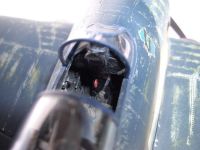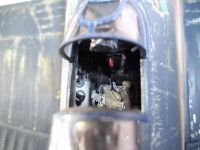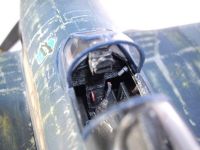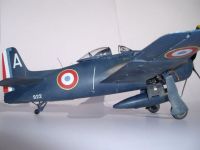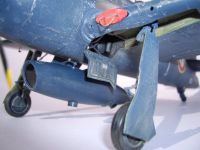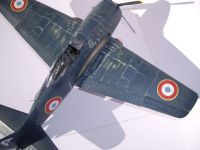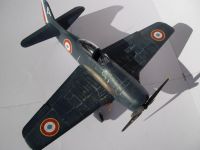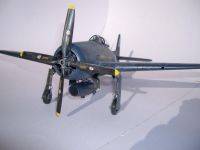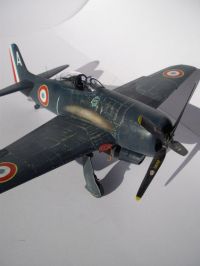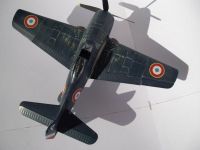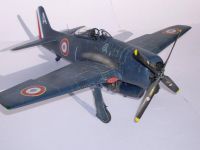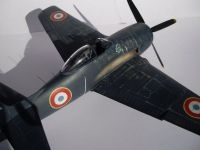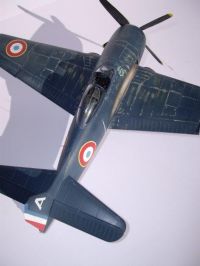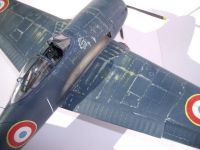1/32 Trumpeter Grumman F8F-1 Bearcat
By Olivier Barles
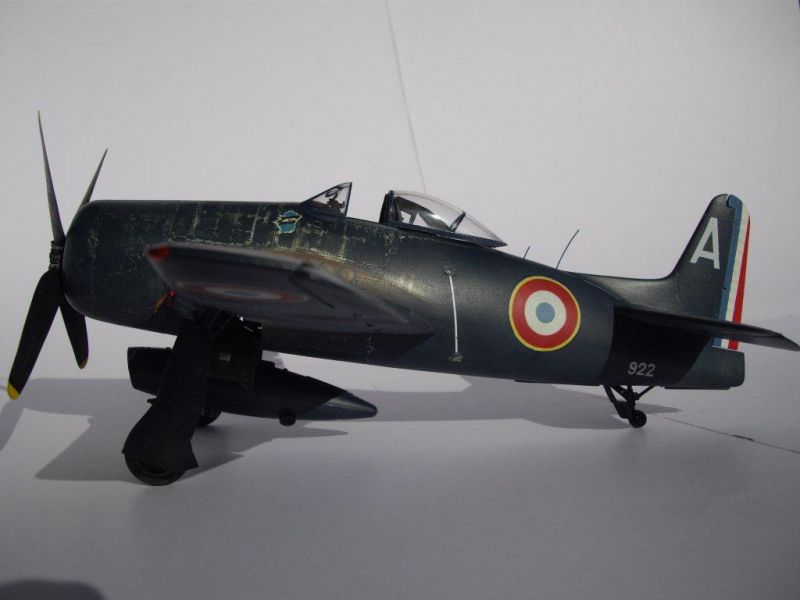
Choosing to represent a Bearcat of the French Air Force operating during the Indochina Conflict in the '50s did satisfy "my devotion" for planes with a dirty look".
The Trumpeter kit is not bad but its main quality is that "it does exist"!
Unfortunately, it belongs to their series of "rivet holes all over" - and all those who've worked on Trumpeter kits of this kind do know what I mean.
So, my first job was to use some light putty to fill those holes at the half posterior part of the fuselage - that looks clean and smooth on all the pictures I could find. Nevertheless, I left rivets at the front part of the fuselage and on the wings, their depth and diameters looking more acceptable in size after using a few coats of paint (that I also applied in an "aging / weathering" purpose).
Second major work was to complete the fuselage section that is visible through the undercarriage wells: putting in cables of different sizes and some scratch-built parts as seen on pictures ended in a satisfying result, concluded by the addition of flexible pipes for the braking system.
Nothing to say about the engine that only needed a good paint work and the confection of the usual missing plugs cables but the propeller needed some detailing, more precisely the pitch mechanism.
Then the cockpit was completed by a few scratch-built parts (mainly on its 2 sides), a careful painting in "moderate black" and the anti-crash pylon was fully re-built with many extra-details around...
Then started the moments of fun...
A first coat of Tamiya Silver followed by a coat of zinc chromate green,
then a dark Navy blue was a good way to make those rivet holes looking
better while giving an excellent painting base to create aging and
weathering effects.
Micromesh, thin sandpaper and a sharp rounded shape blade help getting a realistic look as seen on many photos of the planes in operations.
This Bearcat wears the colours of a F8F-1 flying in a reco squadron named "EROM 80" (Escadrille de Reconnaissance d'Outre-Mer), a squadron created in January 1951 to give eyes to the French Army during the Indochina War that started at the end of WWII, as a first claim for independence from the French trusteeship.
Those planes were extensively used in very hard conditions, from remote airstrips where maintenance represented an everyday challenge.
Truth is that the legendary Grumman's robustness did not need complex or elaborated servicing... And due to both its relative "conceptual simplicity" (the smallest and ruggedness plane around the biggest engine!) and its "easy" maintenance, not only the rate of available machines was usually quite high but the "Bearcat" became the pilots' favorite.
Climbing fast, highly maneuverable, taking well, forgiving enough, its only limitations were its high pressure tires (indeed well designed for a flat deck, but not so well for dusty and stony airstrips) and its short range (partially compensated by the fact that missions were mainly "short distance ones").
Cameras were eventually set in at the tail of the fuselage, but they were firstly fixed in a ventral extra tank. This rustic handy work appeared to be well adapted in this "rugged environment".
Photos show that the main worn out plane areas were the upper wing
surfaces, next to the fuselage. This is what I tried to represent, not
to forget the dusty general appearance... Same work was done on the
propeller to make it getting "an operational look" (this enormous 4
meters diameter propeller strongly participating to the personality of
the Bearcat!) and to finish, I painted those very particular exhaust
pipes marks on the fuselage flanks made of white, brown and very pale
blue...
French roundels were hand painted and the insignia of the EROM 80 was
obtained via the Internet, reduced at the right scale and printed on a
blank decal sheet... Code letters and numbers come form the "extra stuff
box"...
The aim of this deco work was to represent this plane after a few weeks of intensive operations, not to say that after a few months, they usually looked much more exhausted! But for a model, this is about finding the right balance between what still looks realistic and what might look "unrealistically miserable" if going too far in the weathering and aging work. The "scaling effect" does not forgive... Because if doing too much, the risk is to get a model looking like a very old toy, forgotten for years "in a trunk lost in the attic". And this is definitely not what I wanted to achieve in building this kit...
Well... I have to say that I am finally quite satisfied with the look of my Bearcat...hope you will too!
Merci,
Olivier
© Olivier Barles 2012
This article was published on Wednesday, February 15 2012; Last modified on Saturday, May 14 2016

